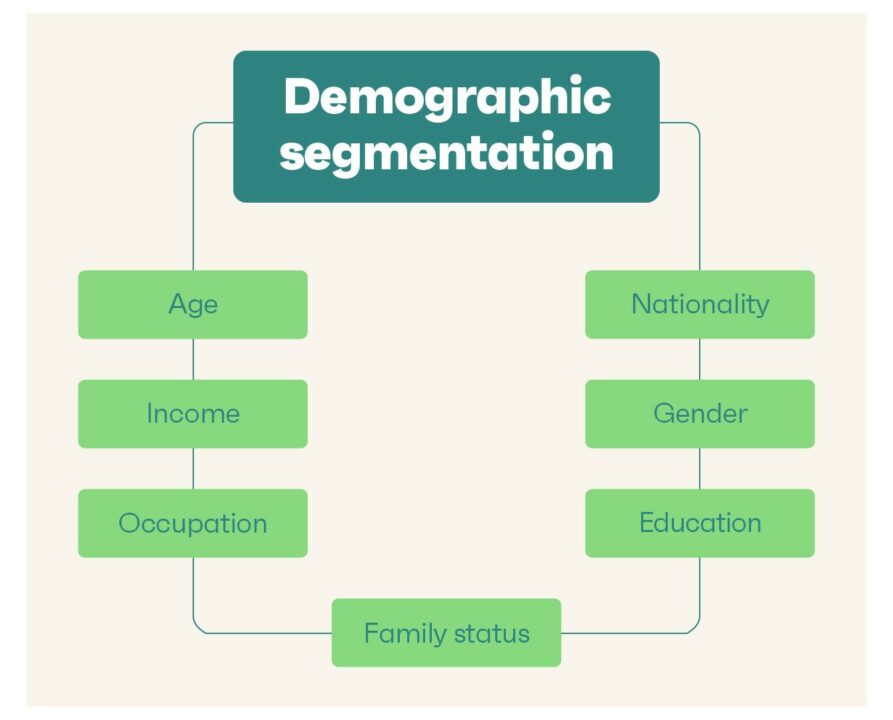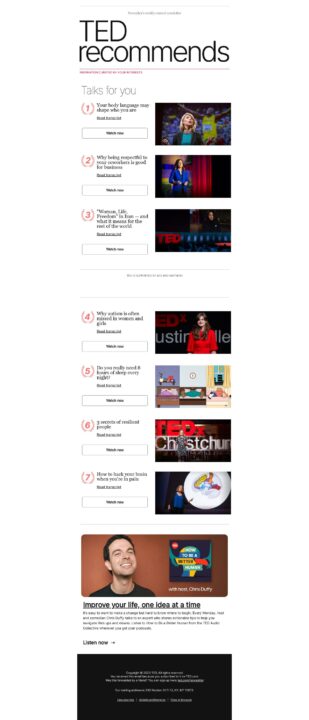To small businesses, market segmentation may seem like a luxury reserved for larger companies. That’s not entirely true.
Market segmentation requires an initial investment, but businesses of any size or level of growth can profit in the long run.
And it’s worth investing in, because it can guide you toward a personalized approach to marketing strategies.
This data-driven analysis can help you better understand your target audience’s needs, as well as reposition your products and services for a better customer experience.
In this guide, we’ll explore the concept of market segmentation and discuss the types and best practices for crafting an effective strategy for 2024.
Let’s get started.
What is market segmentation?
Market segmentation is a strategy marketers use to sort their target market into smaller, more manageable groups. Marketers group these consumers based on their similar characteristics, needs, and desires.
Effective segmentation can help businesses match the preferences of each identified group. It helps businesses tailor their products, services, and campaign messaging.
Some market segments are universal across industries. However, you can create niche segments for specific industries.
For instance, marketing segments for the organic food industry could look like this:
- Individuals engaged in regular workouts, looking for nutrient-dense organic snacks
- Busy individuals who focus on convenience and need quick, portable snacks
- Individuals who express their social identity via food choices
- Individuals who have specific dietary requirements
An in-depth analysis of these segments can help an organic food company to customize its offerings and marketing messages.
Market segmentation and retail customer segmentation are often used interchangeably, but they aren’t the same. Market segmentation involves the broader market and potential customers, whereas customer segmentation involves categorizing existing customers into groups.
Types of market segmentation
There are different metrics to identify market segments. Let’s briefly explore five popular types.
1. Demographic segmentation
Demographic segmentation groups the target market based on their individual traits. These include the following:
- Age
- Gender
- Nationality
- Education
- Occupation
- Income
- Family status

Demographic segmentation assumes that a target audience with similar traits may behave alike. That’s because factors like income and location could influence consumers’ product or service preferences.
Example: 25–35-year-old pet owners in urban areas
2. Geographic segmentation
Similar to demographic segments, you can categorize consumers based on their geographical boundaries. For instance:
- Physical location
- Climate
This approach is essential when expanding operations to another geographical region. It also helps you uncover advertising and sales opportunities.
Example: Mountaineers in the Pacific Northwest region
3. Behavioral segmentation
Behavioral segmentation involves grouping customers based on their distinct behaviors. This considers customers’ actions or interactions with marketing touchpoints, including social media posts, landing pages, or print adverts.
Behavioral segmentation includes the following:
- Buying patterns
- Product usage levels
- Website interactions
- Response to promotions, discounts, and other marketing campaigns
- Decision-making patterns
This technique enables you to understand how consumers engage with brands. It also explains their response to marketing efforts and the buying decision process.
Example: People who often binge-watch TV series and movies
4. Psychographic segmentation
This market segment categorizes consumers based on the psychological elements of their behavior. These elements can be:
- Opinions and preferences
- Lifestyle
- Interests
- Values
- Beliefs
- Life goals
- Status
The psychographic marketing segmentation approach is subjective. It focuses on the personal factors that influence consumer choices. However, it’s ideal for crafting ads to suit a market segment’s lifestyle.
Example: Eco-conscious people
5. Firmographic segmentation
This type of market segmentation is similar to demographics. It’s for business-to-business (B2B) marketers, since it analyzes businesses instead of individuals. The key variables businesses can use for segmentation in marketing include:
- Type of industry or sector
- Company size
- Ownership structure
- Business locations
- Number of years in operation
As a B2B marketer, it’s important to understand different companies’ distinct features. This helps you tailor products, services, market strategies, and sales approaches.
Example: US-based financial service agencies with 100-500 employees operating for 10-20 years
Market segmentation strategy
Knowing your target market helps you sell your products or services to the right people. However, creating a marketing segmentation plan is essential. It determines the appropriate section of the market for your business.
We’ve outlined five main steps for developing a market segmentation strategy.
1. Define the market
Defining the market helps you discover your brand’s niche in the broad target market. However, your product must deliver the value it promises. Defining the market involves identifying the following:
- Businesses operating in similar industries
- Geographic locations where your products or services are relevant
- Key characteristics of potential customers
This process is foundational when creating a market segmentation strategy. It provides a comprehensive understanding of the target market and establishes your market boundaries. This forms a crucial framework for later segmentation in marketing.
2. Segment the market
Marketing segmentation involves dividing a defined market into distinct groups. Here, you’ll use the different types of market segmentation. The following steps result in effective segmentation in marketing:
- Determine the segmentation criteria. This can include age, income, lifestyle, or buying patterns.
- Identify customer clusters with similar traits.
- Aim for homogeneity within each market segment. It should represent a meaningful and identifiable part of your target market.
- Assess the viability of the market segments. Focus on those that offer growth potential and align with your business goals.
Effective segmentation results in targeted marketing efforts. It plays a vital role in crafting personalized marketing messages. In the end, you’ll reach the right set of customers using minimal resources.
3. Understand the market
To understand the market, you must first understand your potential customers. You need to explore their pain points, motivations, and aspirations. Here’s what you should do to understand each market segment:
- Gather consumer insights using surveys or focus groups to understand their purchasing decisions.
- Identify common behaviors and trends.
- Determine each market segment’s most effective communication method and promotional offers.
- Discover what your competitors are doing within similar market segments. Identify gaps and opportunities your business can capitalize on.
Your target market will evolve over time because of ever-changing consumer preferences. Thus, understanding the market isn’t a one-time affair but a continuous process.
4. Create customer segments
This step combines marketing segmentation criteria with identifying common traits within each group. It aims to convert consumer insights into actionable and well-defined groups.
Consider the following when creating customer segments:
- Build comprehensive profiles for each segment.
- Focus on segments that align with your business and have high revenue potential.
- Check for overlaps between segments. This ensures that consumers in many segments get promotions based on their diversity.
With proper marketing segmentation, you’ll boost engagements and conversions.
5. Test your strategy
You can only determine the validity of your strategy through testing. You will use a subset of your market segment to confirm its effectiveness. If your strategy works, you can start the process of implementing the project on a large scale.
The process includes the following:
- Start pilot campaigns and collect performance data. Examples include engagement metrics and conversion rates.
- Establish feedback mechanisms to understand the campaign’s impact on customer satisfaction. You can use surveys, forms, or direct interaction via customer service channels.
- Compare the outcome with that of a control group that receives generic campaign messaging. Identify whether your segmentation strategy yields better results than a non-segmented strategy.
- Identify what worked well and areas that need improvement, then refine your strategy.
- Check if you can scale the strategy for a larger audience. Make sure it doesn’t compromise your strategy’s efficiency.
Main benefits of market segmentation
Market segmentation offers a plethora of benefits and helps you overcome the complexities of a broad target audience. Let’s look at a few market segmentation benefits below.
1. Enhanced targeting precision
Marketers can create targeted marketing messages when they focus on specific consumer traits. This improves engagement and conversion rates because consumers will respond to content that resonates with them.
2. Customized products and services
Market segmentation offers insight into the specific needs and preferences of your targets. As a result, you can align your offerings with consumer expectations. This level of customization fosters customer satisfaction and brand loyalty.
Here’s an example of a personalized email from TED based on a user’s interests and previous browsing behavior:

3. Strategic resource allocation
Segmentation enables you to identify and create segments with high profit potential. As a result, you’ll channel time, money, and efforts in that direction.
Excellent resource allocation maximizes the impact of your marketing efforts. It also minimizes the cost of reaching non-responsive or irrelevant audiences.
4. Responsive product development
Market segmentation facilitates a more responsive approach to product development. Adapting your products to the changing demands of consumers becomes swift and easy.
This agility is essential in dynamic industries like digital payment platforms and ecommerce. In such industries, the trends and consumer preferences evolve fast.
Downsides of market segmentation
Market segmentation presents many advantages for businesses, but it also has some drawbacks.
1. Data privacy issues
Many consumers are concerned about data privacy and security. A Statista survey showed that 42% of US respondents didn’t like how companies use their data.
Thus, collecting consumer information may lead to ethical issues. Businesses may even get potential backlash from security-conscious consumers.
2. Implementation costs
Analyzing consumer data to create market segments can be time-consuming and costly. So, smaller businesses with limited resources may be unable to affect segmentation strategies.
3. Production complexities
Rather than modifying existing products, businesses create new ones. That’s because they want to meet the expectations of specific market segments. This can pose a significant challenge as it consumes resources.
It also affects the profitability and competitiveness of the product. This is particularly true in fast-paced industries like fintech, fashion, and ecommerce.
Common market segmentation mistakes
Breaking down a large target market into smaller chunks isn’t a small feat. It demands time and research expertise, plus efficiency in data analysis. As a result, a few pitfalls surround the process. We’ve highlighted some market segmentation mistakes and how to avoid them.
1. Sole dependence on previous customer behavior
Historical data offers insight into the preferences and needs of consumers. However, these metrics are dynamic and can’t predict future behavior.
Relying only on past customer behavior neglects emerging consumer demands. It also blinds you to shifts in market trends. Hence, you’ll fail to capture new segments. This includes people who haven’t interacted with your brand.
To overcome this pitfall, complement historical data with other types of market segmentation. This ensures that your strategies are responsive to the changing nature of humans.
2. Your segments are unsustainable
Creating long-lasting connections with customers becomes challenging when your market segments are short-lived. Frequent repositioning deprives your business of the opportunity to establish itself in niche markets.
This same principle also applies to business locations. For instance, a location-based business strategy can’t sustainably cater to international clients.
Aligning market segmentation with your business’s long-term objectives is important. Marketers should also learn to identify enduring characteristics within the market segments. These include values and beliefs, consistency in usage patterns, and stable demographics.
Wrap up
Market segmentation is a powerful guide for businesses in an era of hyper-personalization. In this article, we’ve explored the different types of market segmentation and shown how customization reigns supreme when planning marketing efforts.
Businesses need to tailor products, services, and campaigns to specific market segments. This enhances precision in targeting, customer loyalty, and resource allocation. Yet, we must also acknowledge the challenges, especially data privacy issues.
It’s also necessary to avoid common segmentation pitfalls and ensure that market segments are scalable and created using holistic data.
As businesses venture into 2024, there’s a need for accurate marketing segmentation strategies. Armed with these insights, we’re certain you’ll exceed the demands of your diverse customer base.
Source from Omnisend
Disclaimer: The information set forth above is provided by omnisend.com independently of Alibaba.com. Alibaba.com makes no representation and warranties as to the quality and reliability of the seller and products.






